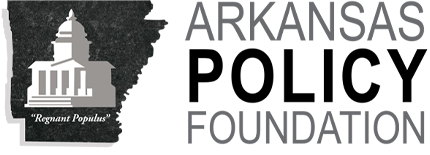“Government, in order to be lean and effective, needs to be infused with market forces; less of a monopoly provider of services and more a broker of services in a competitive; and measured for accountability and performance.”1 Murphy Commission, Policy Foundation Project
First in a series on how to advance Arkansas’ fiscal progress.
(February 2019) Arkansas has made fiscal progress in the post-Clinton era.2 But policies that place it at a competitive disadvantage with other states must be answered with tomorrow’s fiscal reforms if the goal is a stronger economy.
Fiscal Problem: Spending
The first problem is state spending that exceeds U.S. and regional averages on a per capita basis. Data from the Henry J. Kaiser Family Foundation shows3 Arkansas total state expenditures per capita were $8,367 (FY 2017) versus the $5,976 U.S. average, and second-highest in the southeast region.
Total State Expenditures Per Capita
| 1. West Virginia | $9,372 | 7. Alabama | $5,466 |
| 2. Arkansas | $8,367 | 8. Tennessee | $4,890 |
| 3. Kentucky | $7,364 | 9. South Carolina | $4,887 |
| 4. Mississippi | $6,828 | 10. Georgia | $4,760 |
| 5. Louisiana | $6,067 | 11. North Carolina | $4,688 |
| 6. Virginia | $5,939 | 12. Florida | $3,640 |
Per capita state spending was also higher than every border state.
| 1. Arkansas | $8,367 | 5. Tennessee | $4,890 |
| 2. Mississippi | $6,828 | 6. Missouri | $4,179 |
| 3. Louisiana | $6,067 | 7. Texas | $3,925 |
| 4. Oklahoma | $5,918 |
1 Murphy Commission. The Role and Function of State Government. (1998)
2 Bill Clinton was Arkansas governor (1979-1981, 1983-1992). Post-Clinton fiscal reforms include indexing state income tax brackets to CPI (1999), lowering state capital gains (1999, 2013) and income tax (2013-2019) rates; and virtually eliminating the grocery tax (2007-2019).
3 www.kff.org/other/state-indicator/per-capita-state-spending/ Data include general fund, federal funds, other state funds, and bonds. “General Fund: The predominant fund for financing a state’s operations. Revenues are received from broad-based state taxes. There are differences in how specific functions are financed from state to state. Federal Funds: Funds received directly from the Federal government. State Funds: General fund plus other state fund spending, excluding state spending from bonds. Bonds: Expenditures from the sale of bonds, generally for
Arkansas ranked 10th in the U.S. in per capita state spending.
| 1. Alaska | $13,171 | 6. West Virginia | $9,372 |
| 2. Delaware | $11,097 | 7. North Dakota | $8,991 |
| 3. Hawaii | $10,274 | 8. Vermont | $8,910 |
| 4. Oregon | $9,665 | 9. Connecticut | $8,840 |
| 5. New Mexico | $9,380 | 10. Arkansas | $8,367 |
A more efficient Arkansas state government would spend tax dollars at lower per capita levels.
Solution: Limit Spending to CPI
One solution4 is to limit state spending to the Consumer Price Index (CPI). The practical effect is to incentivize officials to search for efficiencies in a low- inflation environment. The goal is not unrealistic: total operational expenditures increased less than the inflation rate at 12 Arkansas agencies.5 But spending was greater than CPI6 at six other agencies: Community Correction, Correction, Economic Development, Education, Environmental Quality, and Health.7 Arkansas per capita state spending would have declined if spending had equaled CPI at these six agencies, a $102.6 million savings.8
— Greg Kaza
Part Two: Cumulative Savings from a CPI-State Spending Limit (2007-)
4 Another solution is to limit state spending to growth in Arkansans income, the subject of a future research memo.
5 Policy Foundation. Arkansas Efficiency Project (2016), p. 13. The agencies were Assessment Coordination, Career Education, Emergency Management, Finance and Administration, Heritage, Higher Education, Insurance, Labor, Parks and Tourism, State Bank, Veterans Affairs, and Workforce Services.
6 CPI was 1.6% (2014) and 0.1% (2015), according to the Federal Reserve Bank of Minneapolis. https://www.minneapolisfed.org/community/financial-and-economic-education/cpi-calculator-information/consumer- price-index-and-inflation-rates-1913
7 The report did not review Human Services, a major source of Arkansas spending growth.
8 Community Correction ($9.8 million), Correction ($35.4 million ), Education ($6.9 million), Environmental Quality









